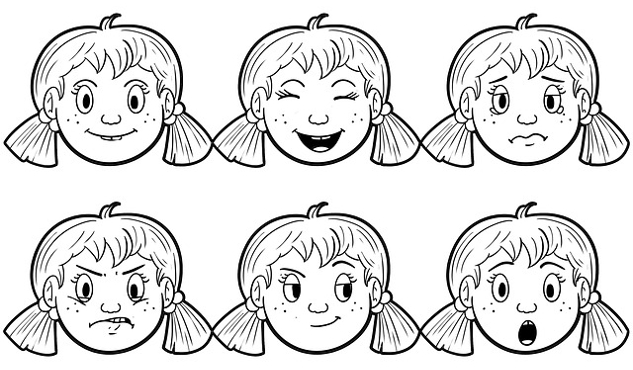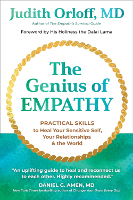
Image from Pixabay
How we attune to ourselves or others may be different for each of us depending on which of the four styles of empathy—cognitive, emotional, intuitive, and spiritual—we relate to most strongly. You can get to know the way you are wired by identifying your primary empathy style (though you may relate to other styles too). Your main style is your default setting, how you naturally express empathy most of the time.
Knowing your style is the starting place to appreciating how your own empathy functions and how you can comfortably give and receive caring. (Note that people with narcissism and others who have empathy deficient disorders don’t have a style of empathy because they lack this quality.)
All styles of empathy can be healing in their own ways. The goal is to make the most of your assets and also experiment with different styles to broaden your options. You may relate to more than one style. For instance, my primary style is intuitive empathy, though I enjoy incorporating cognitive empathy, which is more cerebral, and other types as well. I like having choices in how I respond.
Here are four styles of empathy that I discuss in greater detail in my book The Genius of Empathy. See what style you relate to.
Style 1. Cognitive Empathy: The Thinker/Fixer
If your primary empathy style is cognitive, you’re most comfortable with a concrete, cerebral approach to emotions. Consider this style “thinking empathy.” You use your mind to understand others and wish the best for them. You are solution oriented. You want to logically fix a problem with brain power but are frustrated if you can’t. You may respond to a friend in distress with “I understand that this situation is hurtful, and here’s what you can do about it” rather than, “My heart feels for you,” and then give them space to express their discomfort.
Many physicians show cognitive empathy so they can stay emotionally neutral and just stick to the case’s facts. They prefer analyzing a patient’s pain or dis-ease through test results and technology rather than also attuning to their own feelings and intuitions or helping patients process theirs. During an office visit, they may be glued to their computers taking notes rather than simply listening.
Style 2. Emotional Empathy: The Feeler
If your primary empathy style is emotional, you empathize with others through your emotions. Consider this style “feeling empathy.” You have a big heart and are responsive to people’s needs. You feel everything, but sometimes to an extreme. Like me and many other sensitive empaths, you may be an emotional sponge whose body absorbs others’ distress as well their joy. Since emotions can be contagious, you are vulnerable to catching them.
Neuroscience links emotional empathy to the brain’s mirror neuron system, which generates compassion by mirroring other people’s emotional states. If a friend is hurting, you hurt. If a family member is content, you feel content. It is natural to say to others, “I feel your pain. I care about you.” As an empath, my heart aches along with loved ones when they are going through hard times. Similarly, you are emotionally present with people, and they feel your caring.
Style 3. Intuitive Empathy: The Subtle Senser
If your primary empathy style is intuitive, your keen intuition and sensitivity let you read people and their nonverbal cues more easily. Consider this style “sensing empathy.” Your intuition senses if someone is being authentic or if they aren’t. You have strong gut feelings, ah-ha insights, knowings, or dreams. You also feel the positive and negative vibes that people emit. These vibes come from what Chinese medical practitioners call “chi,” or subtle energy, which extends inches or feet from the skin.
For a subtle senser, the energy someone radiates communicates volumes about them. Albert Einstein believed that everything is energy. Some energy is healing, some is not. For instance, you sense a friend’s creative excitement and receive a boost in your body. Similarly, your positive vibes can uplift them. Or you may sense that someone is struggling despite their outer smile, and their stress jangles you. The invisible language of subtle energy helps you interpret your environment and is a natural way for you to empathically give and receive.
Style 4. Spiritual Empathy: The Mystic
If your primary empathy style is spiritual, you empathize with others through your spirituality. Consider this style “divining empathy,” which describes the process of connecting to spirituality (however you define it) to open your heart. For some, spirituality could be God, Goddess, nature, a creative intelligence, or the power of love.
The divine is a stepping stone to your large, compassionate self. You become a vessel for Spirit as you give and receive empathy. In some spiritual traditions ego = edging God out, which you are less prone to do. This style reflects the sublime perspective of the Prayer of Saint Francis that says,
Make me an instrument of your peace.
Where there is hatred, let me sow love.
Where there is despair, hope. . . .
For it is in giving that we receive.
As an extension of this prayer, you view empathy as a sacred expression of healing that nourishes your soul and the world.
These four empathy styles represent general preferences of how you give and receive but they can be fluid. But I suggest that you experiment with the different styles to keep expanding how you express empathy.
Copyright 2024. All Rights Reserved.
Adapted with permission from The Genius of Empathy
(Publisher: Sounds True) Judith Orloff, MD.
Article Source:
BOOK: The Genius of Empathy
The Genius of Empathy: Practical Skills to Heal Your Sensitive Self, Your Relationships, and the World
by Judith Orloff.
 The Genius of Empathy offers practical, action-driven guidance for connecting our minds and hearts to embody our most authentic, fierce, and compassionate selves. “Cultivating empathy is a kind of peaceful warrior training,” says Dr. Orloff. “You will learn to be both strong and loving, neither a pushover nor rigid. Wherever you are in your life, this book can meet you there and lift you higher.”
The Genius of Empathy offers practical, action-driven guidance for connecting our minds and hearts to embody our most authentic, fierce, and compassionate selves. “Cultivating empathy is a kind of peaceful warrior training,” says Dr. Orloff. “You will learn to be both strong and loving, neither a pushover nor rigid. Wherever you are in your life, this book can meet you there and lift you higher.”
Each chapter is filled with Dr. Orloff’s most valuable insights and tools for living with greater connection, safety, and empowerment as your empathic abilities blossom.
For more info and/or to order this book, click here. Also available as a Kindle edition.
About the Author
 Judith Orloff, MD is a New York Times bestselling author and the author of the book The Genius of Empathy: Practical Skills to Heal Yourself, Your Relationships and the World (with foreword by the Dalai Lama). She has also written The Empath’s Survival Guide and Thriving as an Empath, which offers daily self-care tools for sensitive people. She integrates the pearls of conventional medicine with cutting edge knowledge of intuition, empathy, energy medicine, and spirituality.
Judith Orloff, MD is a New York Times bestselling author and the author of the book The Genius of Empathy: Practical Skills to Heal Yourself, Your Relationships and the World (with foreword by the Dalai Lama). She has also written The Empath’s Survival Guide and Thriving as an Empath, which offers daily self-care tools for sensitive people. She integrates the pearls of conventional medicine with cutting edge knowledge of intuition, empathy, energy medicine, and spirituality.
Dr. Orloff specializes in treating empaths and highly sensitive people in her private practice and online internationally. Her work has been featured on The Today Show, CNN, Oprah Magazine, the New York Times and USA Today. Dr. Orloff has spoken at Google-LA, TEDx U.S. and TEDx Asia.
More information about Dr. Orloff’s Empathy Training Programs for businesses, The Empath’s Survival Guide Online Course and speaking schedule at DrJudithOrloff.com
More Books by this Author




























